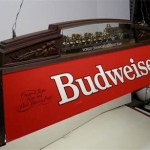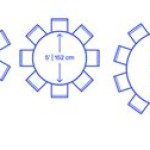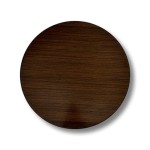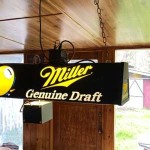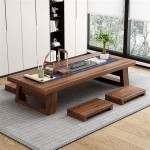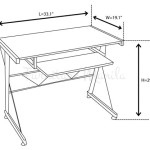How to Make a Lightweight Concrete Table
Concrete tables are a popular choice for both indoor and outdoor spaces, known for their durability and modern aesthetic. However, traditional concrete can be exceptionally heavy, making these tables difficult to move and potentially unsuitable for certain surfaces. Lightweight concrete offers a viable alternative, providing the same desired look and feel with significantly reduced weight. This article details the process of creating a lightweight concrete table, providing a comprehensive guide for individuals interested in this DIY project.
Understanding the composition and properties of lightweight concrete is essential before beginning. Unlike regular concrete, which employs gravel or crushed stone as aggregate, lightweight concrete utilizes lighter materials. These aggregate alternatives can include expanded shale, expanded clay, expanded slate, or even recycled materials like perlite or vermiculite. The choice of aggregate will depend on the desired strength, insulation properties, and finished appearance of the table.
Proper preparation is crucial for a successful lightweight concrete table project. This includes gathering the necessary tools and materials, designing the table's dimensions, and constructing a mold that accurately reflects the intended shape and size. Accuracy in these initial steps directly impacts the final outcome of the project.
Materials and Tools Required
The following list outlines the necessary materials and tools required for constructing a lightweight concrete table:
- Lightweight Concrete Mix: This typically includes Portland cement, lightweight aggregate (e.g., expanded shale, perlite), and admixtures (optional). The specific mix ratio will depend on the chosen aggregate and desired strength, so it is crucial to refer to the manufacturer's instructions.
- Water: Use clean, potable water to achieve the proper concrete consistency.
- Formwork Materials: Melamine-coated particleboard or plywood is recommended for its smooth surface and ease of release. The thickness of the material should be sufficient to withstand the pressure of the wet concrete.
- Release Agent: Form release oil or wax prevents the concrete from bonding to the formwork, ensuring easy removal.
- Reinforcement: Wire mesh or rebar provides structural support and prevents cracking, particularly for larger tables.
- Mixing Tools: A concrete mixer is ideal for larger projects, while a wheelbarrow and shovel can suffice for smaller tables. A drill with a mixing paddle can also be used for smaller batches.
- Measuring Tools: A measuring tape, level, and square are essential for accurate formwork construction and concrete placement.
- Safety Gear: Safety glasses, gloves, and a dust mask are necessary to protect against dust and potential skin irritation from the concrete.
- Finishing Tools: A trowel, float, and sponges are used to smooth and refine the concrete surface.
- Sealer: A concrete sealer protects the table from stains and water damage, extending its lifespan.
- Optional: Concrete pigments can be added to the mix to achieve the desired color. Vibration table or hand-held vibrator to consolidate the concrete and remove air bubbles.
Formwork Construction and Reinforcement
Constructing a sturdy and accurate form is paramount for achieving the desired table shape and dimensions. The formwork should be designed to be easily disassembled after the concrete has cured. The following steps outline the process:
- Design and Cut Formwork Pieces: Determine the desired dimensions of the table and carefully cut the melamine or plywood pieces accordingly. Ensure all cuts are straight and square for accurate assembly.
- Assemble the Form: Use screws or nails to assemble the formwork pieces, creating a box or mold that accurately reflects the table's shape. Ensure all joints are sealed to prevent concrete leakage. Silicone sealant can be used to fill any gaps.
- Apply Release Agent: Thoroughly coat the interior surfaces of the formwork with a release agent. This will prevent the concrete from bonding to the form, making removal significantly easier.
- Install Reinforcement: Place wire mesh or rebar within the formwork to provide structural reinforcement. The reinforcement should be positioned to provide maximum support, particularly in areas prone to stress. Maintain a suitable distance between the reinforcement and the form walls to ensure proper concrete coverage. Small pieces of plastic or concrete spacers can be used to elevate the rebar or mesh.
Mixing and Pouring Lightweight Concrete
The mixing and pouring process requires careful attention to detail to ensure a consistent and durable concrete table. Following these steps will help achieve the desired results:
- Mix the Concrete: Follow the manufacturer's instructions for the specific lightweight concrete mix being used. Typically, this involves combining the dry ingredients (cement, aggregate, and any pigments) thoroughly before adding water gradually. Use a concrete mixer or a mixing paddle attached to a drill for larger batches. For smaller batches, a wheelbarrow and shovel can be used. Add water slowly and consistently until the concrete reaches a workable consistency, similar to that of thick oatmeal. Avoid adding too much water, as this can weaken the concrete.
- Pour the Concrete: Carefully pour the mixed concrete into the formwork, ensuring it fills all corners and crevices. Avoid pouring from a great height, as this can introduce air bubbles. Pour in layers, consolidating each layer before adding the next.
- Consolidate the Concrete: Use a vibration table or hand-held vibrator to consolidate the concrete and remove any trapped air bubbles. This step is crucial for achieving a smooth and dense surface. If a vibrator is unavailable, tap the sides of the formwork with a rubber mallet to help release air bubbles.
- Level the Surface: Use a trowel or screed to level the surface of the concrete, ensuring it is even and smooth.
Curing and Finishing
The curing process is essential for the concrete to gain strength and durability. Proper curing prevents the concrete from drying out too quickly, which can lead to cracking. The finishing process refines the surface and prepares it for sealing.
- Curing: Cover the concrete surface with plastic sheeting or damp burlap to prevent rapid moisture loss. Keep the concrete moist for at least 7 days, preferably longer. This can be achieved by misting the surface with water periodically. The ideal curing temperature is between 50°F and 85°F (10°C and 29°C).
- Demolding: After the curing period, carefully remove the formwork. Loosen the screws or nails and gently pry the formwork pieces away from the concrete. Avoid using excessive force, as this can damage the concrete.
- Surface Finishing: Once the concrete has been demolded, allow it to dry completely. Use a concrete grinder or sandpaper to smooth any rough edges or imperfections. A wet saw can be used to refine the edges and ensure they are straight and even.
- Sealing: Apply a concrete sealer to protect the table from stains and water damage. Choose a sealer that is appropriate for the intended use of the table (indoor or outdoor). Follow the manufacturer's instructions for application. Multiple coats of sealer may be necessary for optimal protection.
Key Considerations for Lightweight Concrete Tables
While lightweight concrete offers advantages in terms of weight reduction, it's important to acknowledge that it typically doesn't achieve the same compressive strength as traditional concrete. Thus, design considerations become critical. Table designs should factor in the lower strength, perhaps using thicker slabs or incorporating more robust reinforcement. A structural engineer or experienced concrete professional can provide valuable insights and recommendations.
The choice of lightweight aggregate significantly impacts the final product. Perlite and vermiculite, for example, are very lightweight but are also relatively weak. Expanded shale or clay offers a better balance of weight and strength. Careful research into the specific properties of each aggregate type is recommended before making a selection. The appearance of the aggregate will also influence the table's aesthetic.
Finally, the addition of admixtures can significantly enhance the properties of lightweight concrete. Air-entraining agents can improve workability and freeze-thaw resistance. Water-reducing agents can increase strength while reducing the amount of water needed. Fiber reinforcement can further improve crack resistance. Experimenting with different admixtures (following the manufacturer's instructions) can yield a superior finished product.

How To Make A Lightweight Concrete Table

Building A Diy Gfrc Concrete Dining Table For Outdoors How To

How To Make A Lightweight Concrete Table

Lightweight Concrete Is It Really Necessary For Countertops

Diy Round Concrete Table Top The Inspired Work

How To Make A Concrete Counter Top In 1 Hour

Lightweight Concrete Furniture

Lightweight Concrete Is It Really Necessary For Countertops

Lightweight Concrete Table Sticks And Stones Outdoor

Lightweight Concrete Table Sticks And Stones Outdoor

